Weightlifting Mesocycles Part 1: General Physical Preparation (GPP) for Weightlifters
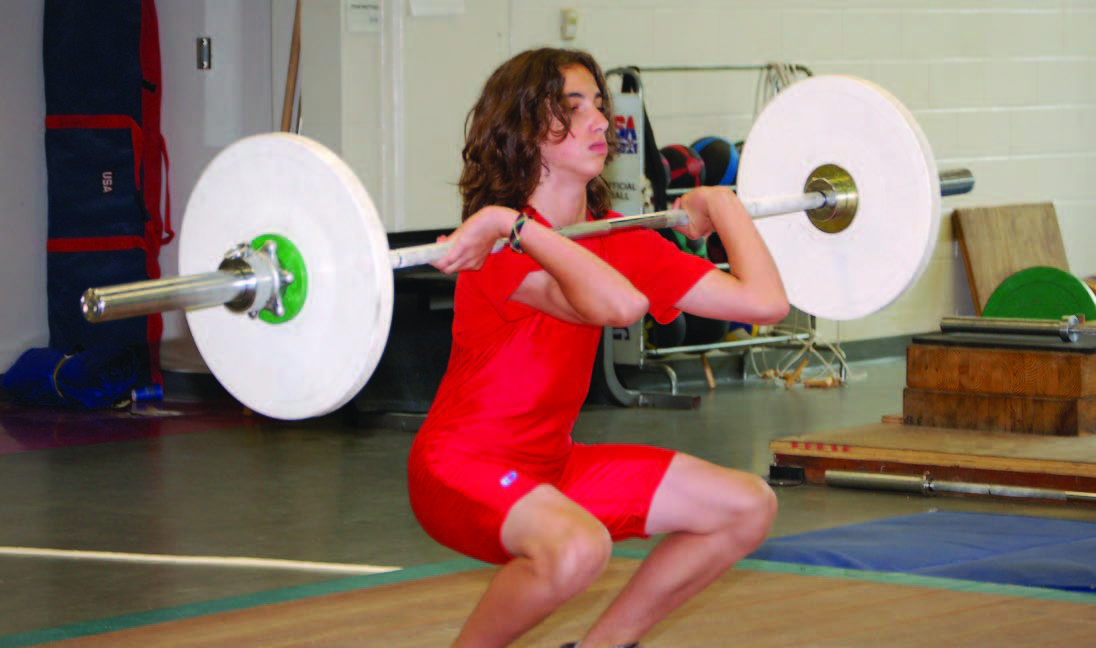
All coaches would like to see their athletes perform their best on the day of competition. A comprehensive, well-planned training program will ensure the best possible results. It is up to the coach to best prepare athletes not only through physical preparation but also through psychological, emotional and rehabilitative measures as well. This lies solely with the coach. What the coach cannot prepare the athlete for is the actual physical conditions of competition day. By this I mean conditions of the venue such as temperature, size and distance of the warm-up room to the competition platform, etc. However, the more prepared an athlete is on competition day, the less effect these unknown conditions will have on them. It all begins with general physical preparation (GPP).
Coaches may have different interpretations of general physical preparation and certainly there is not one definition that encompasses this training phase. However, coaches might agree that GPP would include exercises outside the realm of sport specific training or exercises performed when not in the competition or in-season phase. In weightlifting training, this may include taxing a different energy system with increased repetitions through barbell, dumbbell or kettlebell complexes, medicine ball and bodyweight circuits, short sprints, weighted throws or focusing on increased repetitions in traditional exercises such as the back squat. In this article, I would like to share how Front Range Weightlifting Club incorporates GPP into a 16-week program designed to increase work capacity in an effort to handle greater volume loads to prepare for upcoming training and competition.
In the United States, weightlifting coaches do not rely or follow a national training paradigm. A majority of coaches use paradigms from other weightlifting cultures like “The Bulgarian System,” “The Soviet System” or a system based on the way Asian athletes train. Many utilize a hybrid system encompassing parts or fragments of these systems and incorporate what they have learned through symposia, clinics or physical training themselves to create their own training model. These aforementioned foreign paradigms have shown great success at the highest levels, but many coaches fail to realize that these successful athletes put in many years of general physical preparation within their respective systems, which allows them to handle the workload and to achieve these results. An average weightlifter prepares eight to ten years to achieve success on the international weightlifting platform. A large percentage of that time is spent on GPP.
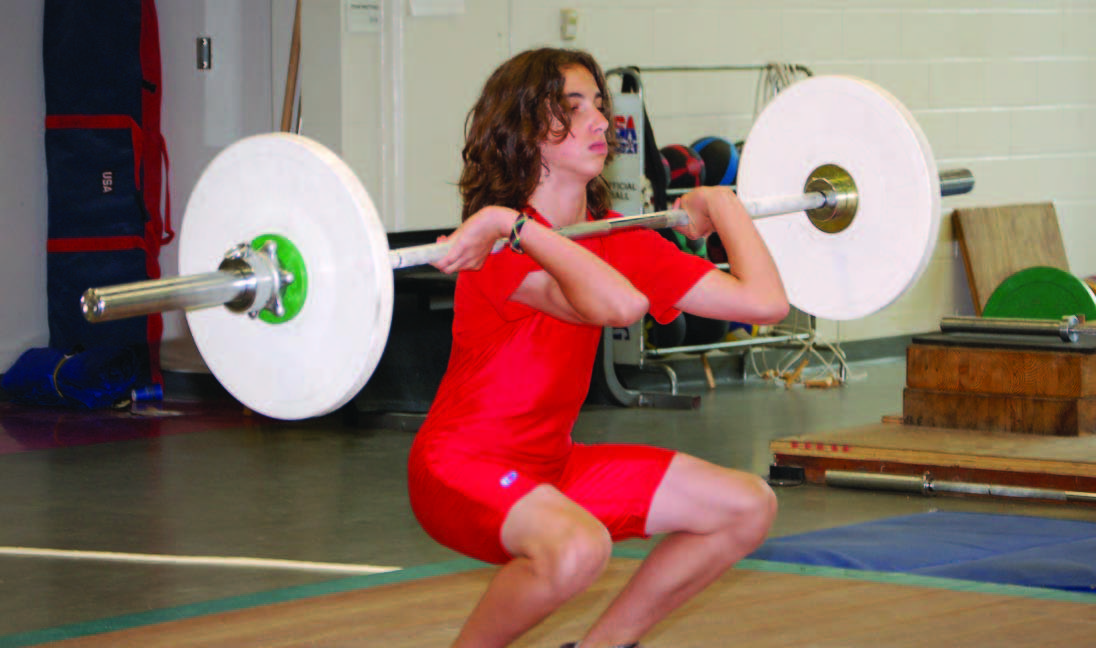
Most coaches break down a quadrennial training plan into more manageable annual training plans, or macrocycles. Within a macrocycle lie mesocycles, typically four-week blocks. Microcycles make up the weekly elements of mesocycles. This article will focus on the GPP mesocycle. In Part 2, I’ll focus on the strength mesocycle. Part 3 will be the conversion to the power mesosycle, and in Part 4 I’ll conclude by focusing on the competition mesocycle.
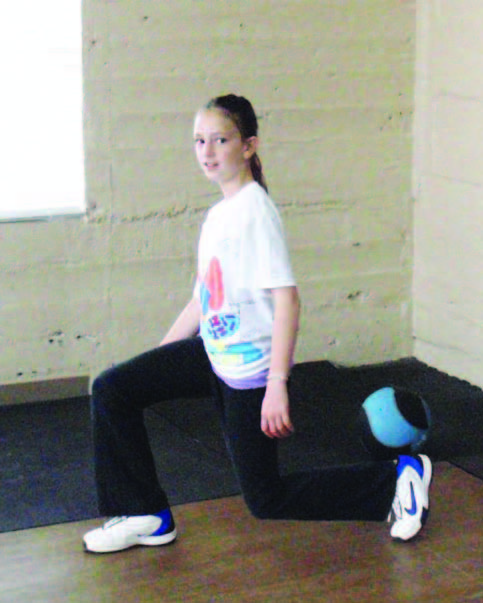
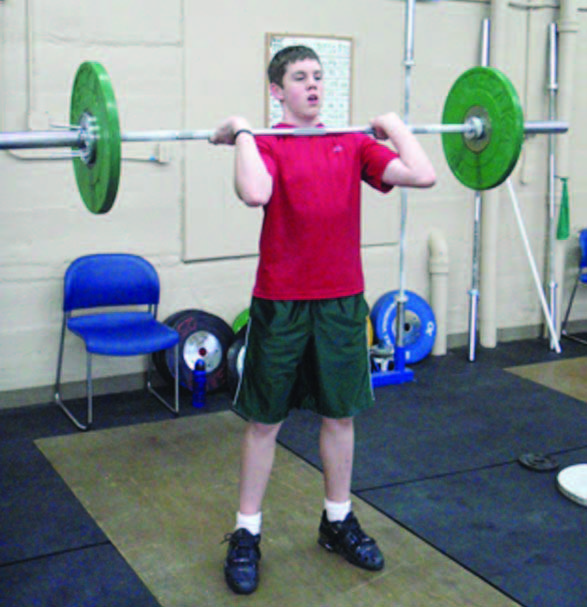
GPP makes up the mesocycle that begins sixteen weeks from a competition and ends twelve weeks from it. What can we expect by the start of week twelve? Given that the athlete is already in shape to begin training we can expect increased work capacity and strength development, general hypertrophy, basic cardiovascular conditioning and a general focus on individual technical deficiencies. The following is a general program used with beginning weightlifters, basically years one through three. Athletes begin by training three days per week with a minimum of one day of rest between training sessions. After showing interest, dedication and a maniacal fervor to continue training, athletes progress to training up to five days per week before graduating to a program which is loosely based off the general program but will have the actual weights in kilograms written in the weekly plan.
The Basic Structure
With beginning lifters, the three components emphasized in this particular phase are learning all of the movements with proper technique, increasing work capacity and improving basic cardiovascular conditioning. The format of the workout begins with a general warm-up then, a more specific dynamic warm-up, a plyometric, the weightlifting exercises and finishing with core.
Warming Up
A comprehensive warm-up focusing on dynamic movements to prepare the neuromuscular system is vital. All athletes begin with a general warm-up which might be something like 500 to 750 meters of rowing, a couple minutes of jumping rope, heavy rope or double unders or low level sprints. They then progress to a medicine ball, barbell, dumbbell or kettlebell circuit, a series of bodyweight exercises or a circuit combining several of these disciplines. Each of these circuits will include five to six exercises with five to ten repetitions performed with minimal to no rest between exercises within the circuit. Because the total reps are relatively high, lighter weights will be used. However, because they are multiple joint, higher skill exercises, the heart rate and core temperature is elevated while the neuromuscular system is geared up for the upcoming workout. It also gives the athlete the opportunity to practice specific weightlifting movements with lighter weights to better understand how the movements are supposed to feel.
The warm-up is followed by either an explosive or reactive plyometric. Many beginning weightlifters are not efficient jumpers, so this gives the coach the opportunity to teach proper mechanics while again preparing the neuromuscular system for the workout proper. All plyometric exercises, whether explosive or reactive, will be performed for two to four sets of ten or less reps. Explosive plyometrics can be categorized by box jumps, squat jumps, lunge squat jumps, broad jumps, triple jumps or weighted jumps. Reactive jumps, when athletes spend as little time on the ground as possible, can be classified as any hurdle jumps, rim touches, speed jumps, split jumps or depth jumps. The warm-up followed by the plyos should take about eight to twelve minutes and will give the athlete the appropriate foundation to begin the weightlifting workout.
Volume & Intensity
These two variables will have great diversity over the 16-week cycle, and coaches interpret volume and intensity differently. This may not be the case with this particular program since weights are not written in the program for beginning weightlifters in their first to approximately third year of training. Athletes use the most amount of weight they can handle with good technique. As soon as technique breaks down, they are asked to lower the weight to compete the sets and reps.
A typical mesocycle in this program will have three hard training weeks with the fourth week being a recovery/unloading week. Volume will be non-linear, varying between 250-350 repetitions per microcycle. The diversity between volume and intensity in the first three microcycles in the GPP mesocycle will not have great variation. However; the recovery/unloading week will typically show less average volume, closer to 250 repetitions, but greater average intensities, at or above 80% of the lifter’s one repetition maximum in the respective lifts.
To try and meet the goals of this mesocycle, exercise selection will be much greater than succeeding mesocycles as will the volume in specific lifts. Volumes for traditional lifts will not be more than three repetitions. However, when incorporating complex lifts, it is not unusual for volumes to be as high as nine repetitions per set. Leg strengthening movements will vary between five to eight repetitions while pulling and overhead movements will be performed between five and six reps per set.
Exercise Selection
Given the previous goals of the GPP mesocycle (proper technique, increased work capacity and basic cardiovascular conditioning) emphasis is placed on complex lifts (traditional movements followed by partial or additional movements), leg strengthening, pull strengthening and overhead strengthening and stability exercises. Every workout on each of the three days will include at least one exercise within the above parameters. The following might be a typical microcycle of the GPP phase.
Day 1:
General warm-up: 500 meter row
Specific warm-up: Med ball circuit (no rest between exercises):
• 10 Ball slams
• 10 Chest pass
• 10 Overhead pass
• 10 Side throws, each side
• 10 Wall ball shots
• 10 Cleans
Plyometric: Box jumps- 3x5
Weightlifting workout:
1. Snatch from power position: 4x5
2. Clean + front squat + push press: 4x3+3+3
• Performed as (3) cleans then (3) front squats then (3) push press
3. Clean pulls: 4x5
4. Squats: 4x8
5. Core & Assistance:
• Back extension: 2x8
• Weighted abs: 2x10
• Push-ups: 2x10
Total reps: 108
The row, med ball circuit and box jumps will ensure a proper neuromuscular warm-up. Exercise 1, snatch from power position, is a partial technical movement focusing on finishing the pull and getting under the bar as quickly as possible. Exercise 2, clean + front squat + push press, is a complex movement focusing on technique and anaerobic capacity. The limiting factor in exercise 1 is the position of the bar at the start of the movement. Because the bar starts high on the upper thigh, intensities will be relatively low to ensure proper movement. The limiting factors in exercise 2 are the push press and the number of repetitions in the set. Even with beginning lifters, the push press will be much lower than the clean and front squat; thus, lighter intensities must be used. In addition, because there are nine repetitions, anaerobic capacity will figure into the weight used as well.
Clean pulls is the pulling exercise emphasizing a proper start and finish while the last exercise, squats, is the leg strengthening exercise focusing on proper positioning throughout all eight repetitions as fatigue may begin to set in. Core & assistance finish the workout, focusing on good habits and proper positioning in the body mass to weight ratio exercises.
Day 2:
General warm-up: 25 double unders or 50 heavy rope skips or 75 rope skips
Specific warm-up: Kettlebell circuit (no rest between exercises):
• 8 Around the body, each way
• 8 High pulls to chin
• 8 Swings
• 8 Snatches, each arm
• 8 Push press, each arm
• 3 Turkish get-ups
Plyometric: Lateral hurdle hops- 3x10
Weightlifting workout:
1. Snatch high pull + snatch: 5x2+3
2. Power clean + clean: 5x3+2
3. Push press behind neck: 4x5
4. DB walking lunges: 4x8
5. Core & Assistance:
• Good mornings: 2x6
• Russian twist: 2x10
• Pull-ups: 2x5
Total reps: 102
Many young athletes have not learned jumping rope or have not performed the exercise for several years. It is an excellent general warm-up for the nervous system. In addition, teaching the athletes the proper form and technique in the Kettlebell movements assists in core strength and stability while also increasing work capacity. Lateral hurdle hops, contrary to box jumps, are a reactive plyometric focusing on reactivity and change of direction.
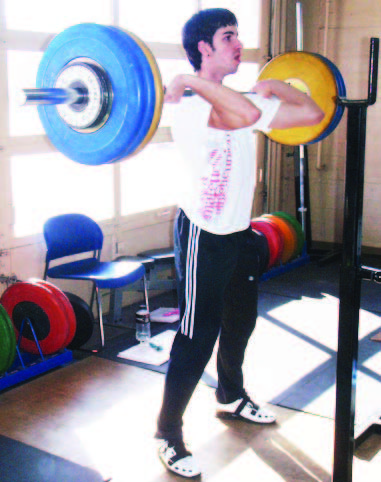
Exercise 1, snatch high pull + snatch, is a complex movement which focuses on correct bar trajectory, thus forcing the athlete to keep the elbows above the bar. If the elbows remain above the bar, it will ensure a correct bar path. Athletes should focus on the elbows when transitioning to the snatch movement again, creating good technical habits. Exercise 2, power clean + clean, is another complex movement that helps the athlete transition from a power movement to a traditional movement with no variation in technique. Many athletes show great disparity between power and traditional movements such as jumping the feet out too far on power movements. This exercise will aid in a seamless transition between the two.
Push press behind neck is an excellent overhead strengthening exercise. Jerk blocks are discouraged for all overhead movements for beginners because the eccentric movement of bringing the bar back to the shoulders is a limiting factor. Because an eccentric movement incurs a 20% increase in load, it is vital that athletes learn how to bring the bar down while gaining strength and confidence in the eccentric portion of the lift.
Lunging is a critical exercise for weightlifters. Due to all of the squatting movements, many athletes gain greater front side mechanics and strength while the antagonistic muscles of the posterior chain, especially the glutes and hamstrings, show inferior strength levels. Lunging will assist with strength levels of the antagonistic muscle groups. Good mornings, transverse abdominals and pull-ups finish off the workout.
Day 3:
General warm-up: Form running
Specific warm-up: Barbell complex (no rest between exercises):
• 6 High pulls below knee
• 6 Muscle snatch below knee
• 6 Back squat to press
• 6 Good mornings
• 6 Bent-over rows
Plyometric: 20 meter broad jumps- 3 sets
Weightlifting workout:
1. Snatch balance: 4x5
2. Snatch from above knee: 4x5
3. Clean + jerk: 4x3+1 (do jerk last)
4. Snatch pulls: 4x5
5. Front squats: 4x5
6. Core & Assistance:
• Reverse hypers: 2x8
• Partner med ball abs: 2x10 each
• Dips: 2x8
Total reps: 96
Total weekly volume: 306 reps
Day 3’s general warm-up is form running, preferably performed on a grass field, and includes skips, lateral slides, carioca, lateral bounds, high knee bounds and sprints. A typical distance is 20 meters; however, distances may vary. Exercises are performed twice, down and back. The setting allows for an easy transition to the plyometric of 20 meter broad jumps. These can be considered an explosive plyometric, for distance, and a reactive plyometric, spending as little time on the ground between jumps as possible.
Snatch balance is an excellent assistance exercise for improving overhead strength and stability and for building confidence in the low squat position. Three traditional cleans followed by a jerk allows the athlete to focus on one movement for three repetitions and then focus on the final movement when fatigued. This is especially effective for athletes who might have poor core strength or are not yet technically sound. This is because it stresses proper positioning for the jerk when exhausted.
Snatch pulls, as with clean pulls, are the pulling exercise emphasizing a proper start and finish for the snatch while front squats emphasize leg strength and proper positioning in the deep squat position. Again, a variety of core & assistance exercises are employed for the end of the workout.
In Conclusion
It has been established that general physical preparation is the cornerstone for setting a foundation for weightlifting training for years to come. A comprehensive, well planned training program has many influences and will affect future performance through a solid foundation of strength, general development and coordination. With patience and nurturing from the coach and consistent training from novice to elite, the athlete should have a long and productive career.
Coaches may have different interpretations of general physical preparation and certainly there is not one definition that encompasses this training phase. However, coaches might agree that GPP would include exercises outside the realm of sport specific training or exercises performed when not in the competition or in-season phase. In weightlifting training, this may include taxing a different energy system with increased repetitions through barbell, dumbbell or kettlebell complexes, medicine ball and bodyweight circuits, short sprints, weighted throws or focusing on increased repetitions in traditional exercises such as the back squat. In this article, I would like to share how Front Range Weightlifting Club incorporates GPP into a 16-week program designed to increase work capacity in an effort to handle greater volume loads to prepare for upcoming training and competition.
In the United States, weightlifting coaches do not rely or follow a national training paradigm. A majority of coaches use paradigms from other weightlifting cultures like “The Bulgarian System,” “The Soviet System” or a system based on the way Asian athletes train. Many utilize a hybrid system encompassing parts or fragments of these systems and incorporate what they have learned through symposia, clinics or physical training themselves to create their own training model. These aforementioned foreign paradigms have shown great success at the highest levels, but many coaches fail to realize that these successful athletes put in many years of general physical preparation within their respective systems, which allows them to handle the workload and to achieve these results. An average weightlifter prepares eight to ten years to achieve success on the international weightlifting platform. A large percentage of that time is spent on GPP.

Most coaches break down a quadrennial training plan into more manageable annual training plans, or macrocycles. Within a macrocycle lie mesocycles, typically four-week blocks. Microcycles make up the weekly elements of mesocycles. This article will focus on the GPP mesocycle. In Part 2, I’ll focus on the strength mesocycle. Part 3 will be the conversion to the power mesosycle, and in Part 4 I’ll conclude by focusing on the competition mesocycle.


GPP makes up the mesocycle that begins sixteen weeks from a competition and ends twelve weeks from it. What can we expect by the start of week twelve? Given that the athlete is already in shape to begin training we can expect increased work capacity and strength development, general hypertrophy, basic cardiovascular conditioning and a general focus on individual technical deficiencies. The following is a general program used with beginning weightlifters, basically years one through three. Athletes begin by training three days per week with a minimum of one day of rest between training sessions. After showing interest, dedication and a maniacal fervor to continue training, athletes progress to training up to five days per week before graduating to a program which is loosely based off the general program but will have the actual weights in kilograms written in the weekly plan.
The Basic Structure
With beginning lifters, the three components emphasized in this particular phase are learning all of the movements with proper technique, increasing work capacity and improving basic cardiovascular conditioning. The format of the workout begins with a general warm-up then, a more specific dynamic warm-up, a plyometric, the weightlifting exercises and finishing with core.
Warming Up
A comprehensive warm-up focusing on dynamic movements to prepare the neuromuscular system is vital. All athletes begin with a general warm-up which might be something like 500 to 750 meters of rowing, a couple minutes of jumping rope, heavy rope or double unders or low level sprints. They then progress to a medicine ball, barbell, dumbbell or kettlebell circuit, a series of bodyweight exercises or a circuit combining several of these disciplines. Each of these circuits will include five to six exercises with five to ten repetitions performed with minimal to no rest between exercises within the circuit. Because the total reps are relatively high, lighter weights will be used. However, because they are multiple joint, higher skill exercises, the heart rate and core temperature is elevated while the neuromuscular system is geared up for the upcoming workout. It also gives the athlete the opportunity to practice specific weightlifting movements with lighter weights to better understand how the movements are supposed to feel.
The warm-up is followed by either an explosive or reactive plyometric. Many beginning weightlifters are not efficient jumpers, so this gives the coach the opportunity to teach proper mechanics while again preparing the neuromuscular system for the workout proper. All plyometric exercises, whether explosive or reactive, will be performed for two to four sets of ten or less reps. Explosive plyometrics can be categorized by box jumps, squat jumps, lunge squat jumps, broad jumps, triple jumps or weighted jumps. Reactive jumps, when athletes spend as little time on the ground as possible, can be classified as any hurdle jumps, rim touches, speed jumps, split jumps or depth jumps. The warm-up followed by the plyos should take about eight to twelve minutes and will give the athlete the appropriate foundation to begin the weightlifting workout.
Volume & Intensity
These two variables will have great diversity over the 16-week cycle, and coaches interpret volume and intensity differently. This may not be the case with this particular program since weights are not written in the program for beginning weightlifters in their first to approximately third year of training. Athletes use the most amount of weight they can handle with good technique. As soon as technique breaks down, they are asked to lower the weight to compete the sets and reps.
A typical mesocycle in this program will have three hard training weeks with the fourth week being a recovery/unloading week. Volume will be non-linear, varying between 250-350 repetitions per microcycle. The diversity between volume and intensity in the first three microcycles in the GPP mesocycle will not have great variation. However; the recovery/unloading week will typically show less average volume, closer to 250 repetitions, but greater average intensities, at or above 80% of the lifter’s one repetition maximum in the respective lifts.
To try and meet the goals of this mesocycle, exercise selection will be much greater than succeeding mesocycles as will the volume in specific lifts. Volumes for traditional lifts will not be more than three repetitions. However, when incorporating complex lifts, it is not unusual for volumes to be as high as nine repetitions per set. Leg strengthening movements will vary between five to eight repetitions while pulling and overhead movements will be performed between five and six reps per set.
Exercise Selection
Given the previous goals of the GPP mesocycle (proper technique, increased work capacity and basic cardiovascular conditioning) emphasis is placed on complex lifts (traditional movements followed by partial or additional movements), leg strengthening, pull strengthening and overhead strengthening and stability exercises. Every workout on each of the three days will include at least one exercise within the above parameters. The following might be a typical microcycle of the GPP phase.
Day 1:
General warm-up: 500 meter row
Specific warm-up: Med ball circuit (no rest between exercises):
• 10 Ball slams
• 10 Chest pass
• 10 Overhead pass
• 10 Side throws, each side
• 10 Wall ball shots
• 10 Cleans
Plyometric: Box jumps- 3x5
Weightlifting workout:
1. Snatch from power position: 4x5
2. Clean + front squat + push press: 4x3+3+3
• Performed as (3) cleans then (3) front squats then (3) push press
3. Clean pulls: 4x5
4. Squats: 4x8
5. Core & Assistance:
• Back extension: 2x8
• Weighted abs: 2x10
• Push-ups: 2x10
Total reps: 108
The row, med ball circuit and box jumps will ensure a proper neuromuscular warm-up. Exercise 1, snatch from power position, is a partial technical movement focusing on finishing the pull and getting under the bar as quickly as possible. Exercise 2, clean + front squat + push press, is a complex movement focusing on technique and anaerobic capacity. The limiting factor in exercise 1 is the position of the bar at the start of the movement. Because the bar starts high on the upper thigh, intensities will be relatively low to ensure proper movement. The limiting factors in exercise 2 are the push press and the number of repetitions in the set. Even with beginning lifters, the push press will be much lower than the clean and front squat; thus, lighter intensities must be used. In addition, because there are nine repetitions, anaerobic capacity will figure into the weight used as well.
Clean pulls is the pulling exercise emphasizing a proper start and finish while the last exercise, squats, is the leg strengthening exercise focusing on proper positioning throughout all eight repetitions as fatigue may begin to set in. Core & assistance finish the workout, focusing on good habits and proper positioning in the body mass to weight ratio exercises.
Day 2:
General warm-up: 25 double unders or 50 heavy rope skips or 75 rope skips
Specific warm-up: Kettlebell circuit (no rest between exercises):
• 8 Around the body, each way
• 8 High pulls to chin
• 8 Swings
• 8 Snatches, each arm
• 8 Push press, each arm
• 3 Turkish get-ups
Plyometric: Lateral hurdle hops- 3x10
Weightlifting workout:
1. Snatch high pull + snatch: 5x2+3
2. Power clean + clean: 5x3+2
3. Push press behind neck: 4x5
4. DB walking lunges: 4x8
5. Core & Assistance:
• Good mornings: 2x6
• Russian twist: 2x10
• Pull-ups: 2x5
Total reps: 102
Many young athletes have not learned jumping rope or have not performed the exercise for several years. It is an excellent general warm-up for the nervous system. In addition, teaching the athletes the proper form and technique in the Kettlebell movements assists in core strength and stability while also increasing work capacity. Lateral hurdle hops, contrary to box jumps, are a reactive plyometric focusing on reactivity and change of direction.

Exercise 1, snatch high pull + snatch, is a complex movement which focuses on correct bar trajectory, thus forcing the athlete to keep the elbows above the bar. If the elbows remain above the bar, it will ensure a correct bar path. Athletes should focus on the elbows when transitioning to the snatch movement again, creating good technical habits. Exercise 2, power clean + clean, is another complex movement that helps the athlete transition from a power movement to a traditional movement with no variation in technique. Many athletes show great disparity between power and traditional movements such as jumping the feet out too far on power movements. This exercise will aid in a seamless transition between the two.
Push press behind neck is an excellent overhead strengthening exercise. Jerk blocks are discouraged for all overhead movements for beginners because the eccentric movement of bringing the bar back to the shoulders is a limiting factor. Because an eccentric movement incurs a 20% increase in load, it is vital that athletes learn how to bring the bar down while gaining strength and confidence in the eccentric portion of the lift.
Lunging is a critical exercise for weightlifters. Due to all of the squatting movements, many athletes gain greater front side mechanics and strength while the antagonistic muscles of the posterior chain, especially the glutes and hamstrings, show inferior strength levels. Lunging will assist with strength levels of the antagonistic muscle groups. Good mornings, transverse abdominals and pull-ups finish off the workout.
Day 3:
General warm-up: Form running
Specific warm-up: Barbell complex (no rest between exercises):
• 6 High pulls below knee
• 6 Muscle snatch below knee
• 6 Back squat to press
• 6 Good mornings
• 6 Bent-over rows
Plyometric: 20 meter broad jumps- 3 sets
Weightlifting workout:
1. Snatch balance: 4x5
2. Snatch from above knee: 4x5
3. Clean + jerk: 4x3+1 (do jerk last)
4. Snatch pulls: 4x5
5. Front squats: 4x5
6. Core & Assistance:
• Reverse hypers: 2x8
• Partner med ball abs: 2x10 each
• Dips: 2x8
Total reps: 96
Total weekly volume: 306 reps
Day 3’s general warm-up is form running, preferably performed on a grass field, and includes skips, lateral slides, carioca, lateral bounds, high knee bounds and sprints. A typical distance is 20 meters; however, distances may vary. Exercises are performed twice, down and back. The setting allows for an easy transition to the plyometric of 20 meter broad jumps. These can be considered an explosive plyometric, for distance, and a reactive plyometric, spending as little time on the ground between jumps as possible.
Snatch balance is an excellent assistance exercise for improving overhead strength and stability and for building confidence in the low squat position. Three traditional cleans followed by a jerk allows the athlete to focus on one movement for three repetitions and then focus on the final movement when fatigued. This is especially effective for athletes who might have poor core strength or are not yet technically sound. This is because it stresses proper positioning for the jerk when exhausted.
Snatch pulls, as with clean pulls, are the pulling exercise emphasizing a proper start and finish for the snatch while front squats emphasize leg strength and proper positioning in the deep squat position. Again, a variety of core & assistance exercises are employed for the end of the workout.
In Conclusion
It has been established that general physical preparation is the cornerstone for setting a foundation for weightlifting training for years to come. A comprehensive, well planned training program has many influences and will affect future performance through a solid foundation of strength, general development and coordination. With patience and nurturing from the coach and consistent training from novice to elite, the athlete should have a long and productive career.
| Paul Fleschler is the owner of Front Range Sports Performance & Fitness and RedRocks CrossFit in Colorado Springs. He earned a masters degree in Motor Control and Learning from Indiana University, is a Certified Strength & Conditioning Specialist and USA Weightlifting Senior International Coach where he has represented the United States at several international weightlifting competitions as Head and Assistant Coach. As an athlete, Paul’s greatest honor was representing the United States at the 1992 Barcelona Olympics. Paul is the former Men’s National Coach and former Men’s and Women’s Resident Coach at the Olympic Training Center in Colorado Springs. He also served in a supportive role for USA Weightlifting at the 2004 and 2008 Olympic Games. Paul assisted with 20 varsity sports at Indiana University, and served as the Head Strength Coordinator for Indiana University Basketball. |
Search Articles
Article Categories
Sort by Author
Sort by Issue & Date
Article Categories
Sort by Author
Sort by Issue & Date

